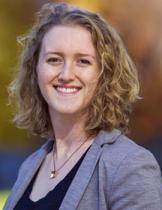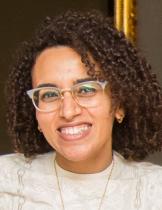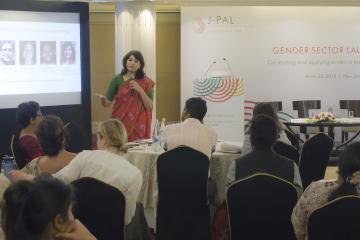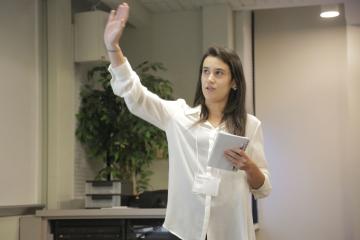
Rahma Ali, J-PAL ‘21, on bringing together statistics and purpose for development research
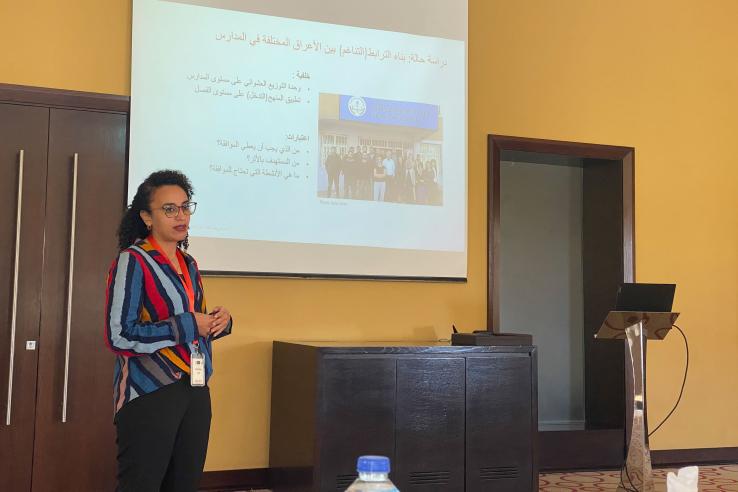
The Alumni Spotlight series highlights J-PAL alumni who are making an impact across industries and around the world. To nominate a J-PAL alum to be featured in a future Alumni Spotlight, please fill out this form.
Rahma Ali is a former research manager at J-PAL Middle East and North Africa, where she was at the forefront of establishing the office’s research operations in Egypt and pushing forward randomized evaluations on employment and livelihood generation in the country. Now at Global TIES for Children at New York University, she builds on her background in randomized evaluation research with new methodological approaches to understand the impact of the pandemic on families’ mental health and well-being. She shares reflections on her path into development research and what excites her about her new role.
What drew you to become a researcher in the development space, and what led you to J-PAL?
It goes back to college. I was a statistics major at Cairo University, but I had to take some political science courses to graduate. I was expecting it to be abstract and detached from reality, but the class I happened to take was all about connecting events in the real world to the theory of political science. There was a big focus in the class on the role of NGOs and the third sector in Egypt, which was my first introduction to the nonprofit sector and international organizations like the UN or the World Bank. I was fascinated, so much so that when the professor asked us what we wanted to do after graduation, I said I wanted to work for the UN. I’ve changed a lot since then, but the idea of working in development and pursuing jobs with purpose sparked in that class.
A friend of mine worked at a research center focused on civic engagement and philanthropy based at the American University in Cairo. On her advice, I applied for and got a job there, researching volunteering and giving in Egypt and Saudi Arabia. But I had a degree in statistics and I wanted to do quantitative work, and I didn't feel that it was completely utilized in that job. When I found out about the J-PAL MENA initiative through my AUC network, I was so excited because it felt like the perfect combination of meaningful work where I could use my skills.
I asked around my office to see if anyone knew anyone at J-PAL, and got connected to AbdelRahman Nagy, then a policy and research manager at J-PAL MENA. I sent him my resume and heard back immediately that they needed a research associate for a new project—and that was how it began!
Could you tell us about some of the evaluations you supported, first as a research associate and later as a research manager?
I started on two parallel projects and it was a very interesting first experience with the kind of work that J-PAL does. We were evaluating the impact of job training counseling on job seekers’ wage employment in Cairo and self-employment in urban Cairo and rural Upper Egypt.
The partner was the Egyptian Micro, Small, and Medium Enterprise Development Agency (MSMEDA), which was a really cool experience because I got to meet with government officials and explain the nitty gritty details of RCTs and try to sell them on the methodology. The World Bank was a funder of the project, so I also met with them. It was impressive to see how much people listened to us, which I believe was thanks to J-PAL’s immense credibility and impact evaluation expertise.
In the course of fieldwork, I worked with our implementing partners, small grassroots NGOs in Upper Egypt. These organizations operated very differently and had different communication styles and needs than MSMEDA or the World Bank. Learning to work with these three very different groups was great exposure for me.
The work was very hands-on, and my research associate colleague and I mostly had to learn by doing. It took some time until we had processes for everything worked out. But that’s a big part of how my role evolved—I went from trial and error to establishing processes that would later on not just help me do my job, but also help others and keep our work consistent, especially when it came to managing and analyzing the data.
I didn’t make it to the annual J-PAL/IPA research staff training until my second year. By that time I already knew a lot about the practical aspects of the research job, but the training taught me so much about the J-PAL and IPA network and the two sister organizations’ shared work. It opened my eyes to the bigger picture: how we’re not just working on these separate projects, but also working to generate evidence across sectors so that we can make recommendations to policymakers.
Watching the data that I collected myself go from the survey all the way up to being presented in front of very influential people in the government was incredible. Having this holistic picture of our work is really one of the most amazing things about J-PAL, knowing that you can see the impact of the research that you spend countless hours on.
You joined our Middle East and North Africa (MENA) team prior to its official launch as a regional office, when J-PAL was still operating as an initiative in the region. Could you describe for us how you saw our work—and the MENA team—evolve over the more than three years you worked there?
I think the launch of the office would have never been a reality without the extreme dedication of the founding staff. They really believed in J-PAL’s work even before we had any formal presence in Egypt. AbdelRahman Nagy, who was absolutely instrumental in establishing J-PAL in Egypt, had a vision for evidence-informed policymaking in the region, and it really touched each and every one of us.
The office hierarchy was very flat, which required a great sense of responsibility from each individual to wake up in the morning knowing what they needed to do and act accordingly. Doing field research in Egypt can be very challenging and demanding, and not everyone could thrive in such an environment. That’s why I really attribute what J-PAL MENA has become today to the high sense of initiative, dedication, and purpose of the staff.
You moved on from J-PAL last spring to join another academic research center, Global TIES for Children based at New York University. Could you tell us about the center and your role there?
Global TIES for Children is an academic center that researches interventions related to child development in low-income and conflict-affected countries. The mission is not so different from J-PAL’s, except it’s more focused on a more specific population and set of outcomes. We also don’t stick to a specific research methodology, and this gives us a high level of flexibility.
It has been a breath of fresh air to use different methods and work in new geographies outside of Egypt and the Middle East. I’m not really heavily involved in data collection anymore, as it is completely in the hands of a survey company we work with. This set up allows me to focus my time more on methodology and analysis.
At Global TIES I have a high level of flexibility when it comes to setting research questions and proposing methodology, and even more autonomy than I had at J-PAL. This is fun at times but it's also very challenging at others, because you need to figure things out on your own.
What is an interesting research project you are currently working on?
Since I joined during the Covid-19 pandemic, my work is all about questions related to Covid now. For example, I’m collaborating with two psychologists and one economist on three research projects on parent and child well-being and family relationships throughout the pandemic, in the United Arab Emirates, Jordan, and Pakistan. Through several rounds of data collection from before and during Covid, we’re seeing how these outcomes have changed over the pandemic.
Through this project I’ve learned to work with latent variables, which are quite different from the error free measurements that I’m used to working with in economics like income, for example, or how many times you go to school. In these new projects, I work with latent constructs that are not typically conveyed directly by responding to one question. Moreover, it requires additional considerations to verify that these questions indeed measure what we’re trying to measure. It's something that I hadn't been exposed to at J-PAL, just because it's a different discipline. This has given me the chance to explore new models and analytical approaches, which has really advanced my quantitative skills.
What have you learned from this shift to new methods, and how does this shape the ways you seek to answer research questions?
It’s a good reminder that not all development questions can be answered by RCTs. I don’t doubt that it’s the most rigorous method, but it’s not always the most viable solution you can resort to. In reading and producing more non-RCT research, I’ve had to adjust to a certain way of phrasing results and findings. RCT design can be very complicated, but having causality established by design makes interpretation of results more straightforward. With other non-experimental methods, there's uncertainty that you have to account for and justify when presenting your findings. It’s been challenging for sure, but also fun to work with. Doing either experimental or non-experimental research contributes to the literature of human development, which is much needed especially when it is for vulnerable populations.
